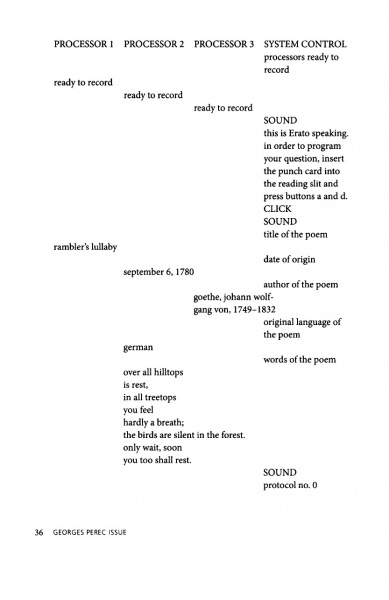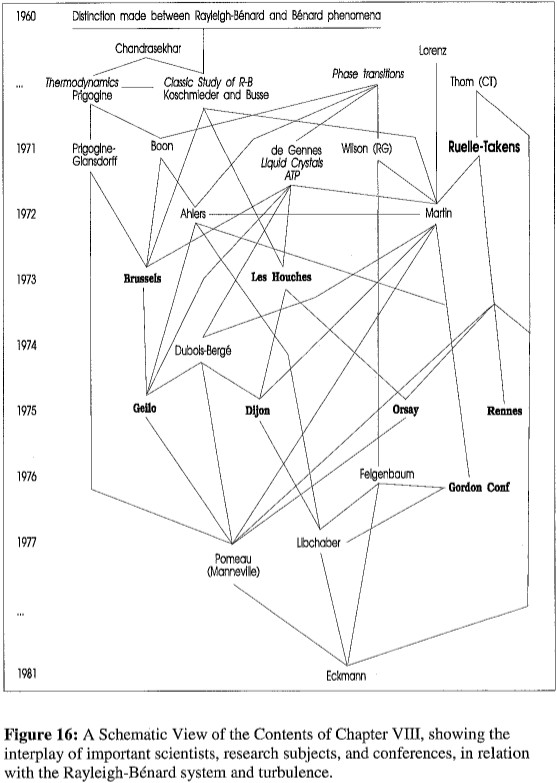Georges Perec: Species of Spaces and Other Pieces (1974–) [FR, DE, EN, ES, GR, CR, RU]
Filed under book | Tags: · literature, oulipo, space, writing

Georges Perec produced some of the most entertaining essays of the age. His literary output was deliberately varied in form and style and this selection of Perec’s non-fictional work also demonstrates his characteristic lightness of touch, wry humour and accessibility.
Publisher Galilée, Paris, 1974
125 pages
English edition
Edited with an Introduction and Translated by John Sturrock
Publisher Penguin, 1998
ISBN 0140189866, 9780140189865
96 pages
via thecryingroom
WorldCat (EN)
Espèces d’espaces (French, DJVU, 1974/1985, updated on 2019-10-11)
Träume von Räumen (German, trans. Eugen Helmlé, 1994, 14 MB, Scribd, updated on 2019-10-11)
Species of Spaces and Other Pieces (English, trans. John Sturrock, 1998)
Especies de espacios (Spanish, trans. Jesús Camarero, 1999/2001)
Χορείες χώρων (Greek, trans. Αχιλλέας Κυριακίδης, 2000)
Vrste prostora (Croatian, trans. Petra Matić, 2005, 43 MB, Scribd)
Prosto prostranstva: Dnevnik polzovatelya (Russian, trans. Valeriy Kislov, 2012, updated on 2019-10-11)
Georges Perec: The Machine (1972/2009)
Filed under play | Tags: · algorithm, computing, machine, oulipo
One of Georges Perec’s Oulipian works, the radio play The Machine was written “in collaboration with his German translator and close friend, Eugen Helmle, in the heady atmosphere of the Saarbrücken literary circle that met at Helmle’s house. The Machine is an early example of writing inspired by the existence of modern computers (Perec’s other computer-simulation, a stage play entitled [L’Augmentation, appeared in English as The Art of Asking Your Boss for a Raise in 2011]). It pretends to analyze and recompose, demolish and then rebuild a short lyric by Goethe that is almost indescribably well-known to all speakers and learners of German. To do this, it uses pretty much all the rewriting devices invented to date by Oulipo, and at the outset of Perec’s apprenticeship to a group that included many scientists and mathematicians far more learned than he, it served as a kind of demonstration piece, or Meisterstuck. Its inventiveness, irreverence, and closing sadness has made it just about the best-loved and most frequently rebroadcast example of the Neues Hörspiel, the name given to the experimental reinvention of radio drama that was such a marked feature of German literary culture in the 1960s and 1970s. Perec is nothing it not international.” (from David Bellos’s Introduction to the Review‘s special issue)
First broadcast on 13 November 1968 by Saarländischer Rundfunk, Saarbrücken
First published in German as Die Maschine, Reclam, Stuttgart, 1972
English translation by Ulrich Schönherr
Published in Review of Contemporary Fiction 26(1), Special Issue on Georges Perec, 2009
61 pages (pp 33-93)
via lermontov
Review (M.A. Orthofer, The Complete Review, 2009)
Commentary (Florian Cramer, Words Made Flesh, 2005)
Commentary (Hans Hartje, 1997, in French)
Commentary on a live performance of the English translation (Third Angel, 2012)
David Aubin: A Cultural History of Catastrophes and Chaos: Around the Institut des Hautes Études Scientifiques, France 1958-1980 (1998)
Filed under thesis | Tags: · biology, catastrophe theory, chaos theory, history of mathematics, history of science, linguistics, mathematics, oulipo, physics, science, semiotics, structuralism, turbulence
“This is the story of a group of scientists who, in the local context of the Institut des Hautes Études Scientifiques (IHÉS), France, contributed to the elaboration of catastrophe theory and deterministic chaos theory. Starting with a study of the role of Bourbaki’s mathematics on the French intellectual scene (and especially with respect to structuralism), this dissertation examines the resources from topology, embryology, and linguistics used by René Thom to construct catastrophe theory.
It describes the foundation of the IHÉS by Léon Motchane in 1958 and the ideology of fundamental research that shaped it. It reviews the history of structural stability for differential equations, focusing on the work of Aleksandr Andronov and Solomon Lefschetz, among others, and the synthesis achieved in the 1960s by Stephen Smale at the University of California, Berkeley. These mathematical developments were used by Thom to develop new modeling practices. The IHÉS, which welcomed topologists such as E. Christopher Zeeman and Ralph Abraham, played a role in developing modeling practices based on recent advances in topology. A physics professor at the IHÉS, David Ruelle, together with Dutch mathematician Floris Takens, adapted the modeling practices of these ‘applied topologists’ and proposed a mechanism for the onset of turbulence, thereby introducing the concept of strange attractors. Looking at the history of fluid mechanics, I argue that Ruelle’s work displaced earlier emphases on fundamental laws, like the Navier-Stokes equations, and focused on the modes of representation rather than representations themselves. A certain Bourbakization of physics and the advent of the computer shaped this evolution.
Finally, focusing on convention, and taking the Rayleigh-Bénard system as a boundary system, various communities’ responses to the Ruelle-Takens model are examined, in particular hydrodynamic stability theorists, phase transition physicists and Pierre-Gilles de Gennes’s group, and chemical physicists orbiting Ilya Prigogine. Prior interest in developing interdisciplinary approaches for the study of turbulence helped the adaptation of a dynamical systems approach for the study of natural phenomena, greatly inspired by the work of Smale, Thom, and Ruelle.” (Abstract)
Ph. D. thesis
Princeton University
782 pages
single PDF (final section “Sources and Bibliography” missing; no OCR)
PDF chapters (from the author’s website)



